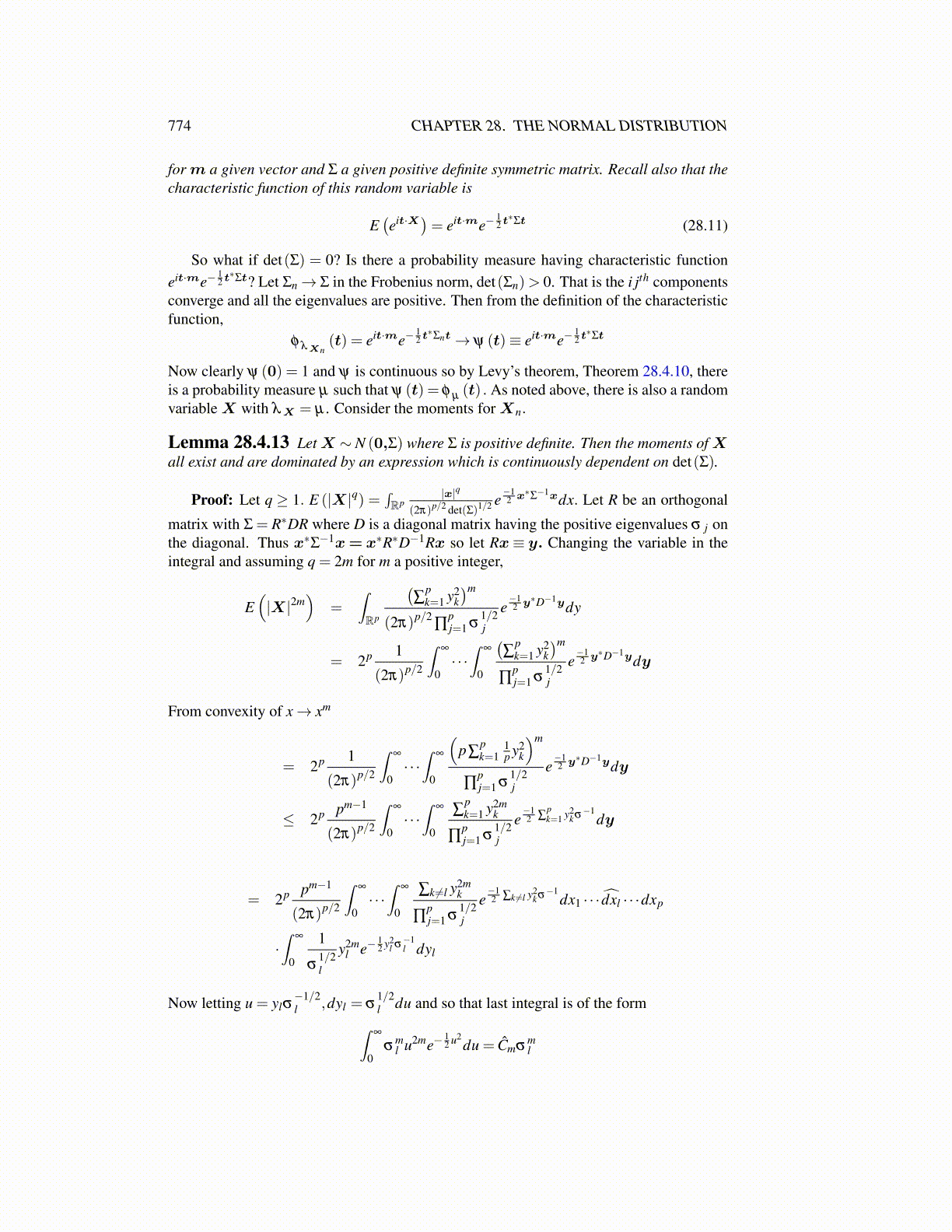
774 CHAPTER 28. THE NORMAL DISTRIBUTION
form a given vector and Σ a given positive definite symmetric matrix. Recall also that thecharacteristic function of this random variable is
E(eit·X)= eit·me−
12 t∗Σt (28.11)
So what if det(Σ) = 0? Is there a probability measure having characteristic functioneit·me−
12 t∗Σt? Let Σn→ Σ in the Frobenius norm, det(Σn)> 0. That is the i jth components
converge and all the eigenvalues are positive. Then from the definition of the characteristicfunction,
φ λXn(t) = eit·me−
12 t∗Σnt→ ψ (t)≡ eit·me−
12 t∗Σt
Now clearly ψ (0) = 1 and ψ is continuous so by Levy’s theorem, Theorem 28.4.10, thereis a probability measure µ such that ψ (t) = φ µ (t) . As noted above, there is also a randomvariableX with λX = µ . Consider the moments forXn.
Lemma 28.4.13 LetX ∼ N (0,Σ) where Σ is positive definite. Then the moments ofXall exist and are dominated by an expression which is continuously dependent on det(Σ).
Proof: Let q ≥ 1. E (|X|q) =∫Rp
|x|q
(2π)p/2 det(Σ)1/2 e−12 x∗Σ−1xdx. Let R be an orthogonal
matrix with Σ = R∗DR where D is a diagonal matrix having the positive eigenvalues σ j onthe diagonal. Thus x∗Σ−1x= x∗R∗D−1Rx so let Rx≡ y. Changing the variable in theintegral and assuming q = 2m for m a positive integer,
E(|X|2m
)=
∫Rp
(∑
pk=1 y2
k
)m
(2π)p/2∏
pj=1 σ
1/2j
e−12 y∗D−1ydy
= 2p 1
(2π)p/2
∫∞
0· · ·∫
∞
0
(∑
pk=1 y2
k
)m
∏pj=1 σ
1/2j
e−12 y∗D−1ydy
From convexity of x→ xm
= 2p 1
(2π)p/2
∫∞
0· · ·∫
∞
0
(p∑
pk=1
1p y2
k
)m
∏pj=1 σ
1/2j
e−12 y∗D−1ydy
≤ 2p pm−1
(2π)p/2
∫∞
0· · ·∫
∞
0
∑pk=1 y2m
k
∏pj=1 σ
1/2j
e−12 ∑
pk=1 y2
kσ−1dy
= 2p pm−1
(2π)p/2
∫∞
0· · ·∫
∞
0
∑k ̸=l y2mk
∏pj=1 σ
1/2j
e−12 ∑k ̸=l y2
kσ−1dx1 · · · d̂xl · · ·dxp
·∫
∞
0
1
σ1/2l
y2ml e−
12 y2
l σ−1l dyl
Now letting u = ylσ−1/2l ,dyl = σ
1/2l du and so that last integral is of the form∫
∞
0σ
ml u2me−
12 u2
du = Ĉmσml